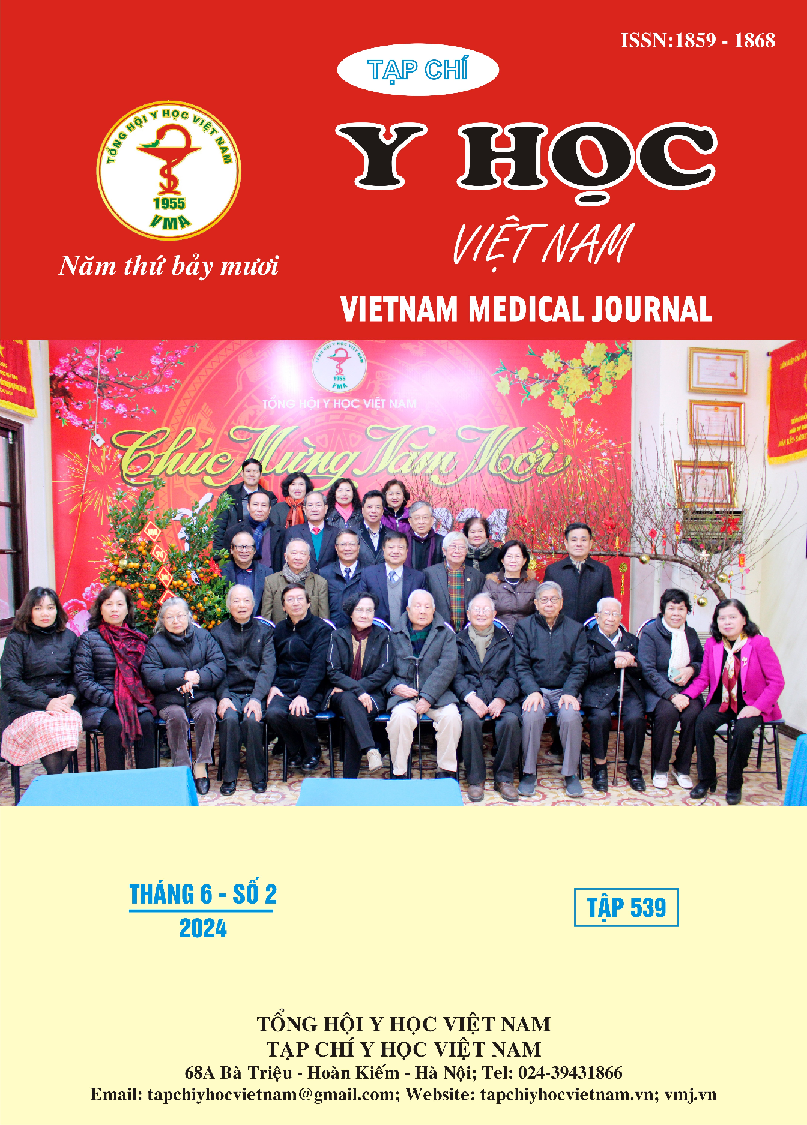ĐÁNH GIÁ MỐI TƯƠNG QUAN GIỮA TRIỆU CHỨNG VÀ MỨC ĐỘ ĐAU KHỚP THÁI DƯƠNG HÀM VỚI HÌNH ẢNH CỘNG HƯỞNG TỪ Ở BỆNH NHÂN CÓ RỐI LOẠN NỘI KHỚP
Nội dung chính của bài viết
Tóm tắt
Mục tiêu: Nghiên cứu nhằm đánh giá mối tương quan giữa triệu chứng và mức độ đau khớp thái dương hàm (TDH) với những bất thường trên hình ảnh cộng hưởng từ (CHT) ở những bệnh nhân nghi ngờ có hội chứng rối loạn nội khớp thái dương hàm. Đối tượng và phương pháp nghiên cứu: Nghiên cứu mô tả tiến cứu tại Bệnh viện Đại học Y Hà nội từ 9/2023 đến 1/2024 trên các bệnh nhân nghi ngờ có hội chứng rối loạn nội khớp TDH. Tất cả các bệnh nhân được khai thác triệu chứng đau và mức độ đau theo thang điểm VAS, sau đó được chụp CHT khớp TDH. Các bất thường trên hình ảnh CHT của khớp TDH sẽ được đối chiếu nhằm xác định mối tương quan với triệu chứng và mức độ đau trên lâm sàng. Kết quả: Tổng cộng có 54 bệnh nhân với 88 khớp TDH đã được đưa vào nghiên cứu, tuổi trung bình 27±11,9, thấp nhất 11 tuổi, cao nhất 68 tuổi. Có mối tương quan mạnh giữa triệu chứng và mức độ đau với bất thường vị trí đĩa khớp (p<0,01, r=0,44), bất thường hình dạng lồi cầu (p<0,01, r=0,5) và dịch ổ khớp trên CHT (p<0,01, r= -0,5). Có mối tương quan yếu giữa bất thường hình dạng đĩa khớp với triệu chứng và mức độ đau (p<0,01, r=0,29). Kết luận: Có mối tương quan giữa triệu chứng và mức độ đau khớp TDH với tình trạng di lệch đĩa khớp, thoái hoá chỏm lồi cầu và dịch trong ổ khớp trên CHT.
Chi tiết bài viết
Từ khóa
Rối loạn nội khớp thái dương hàm, cộng hưởng từ, đau khớp TDH.
Tài liệu tham khảo
2. Paesani D, Westesson P-L, Hatala M, Tallents RH, Kurita K. Prevalence of temporomandibular joint internal derangement in patients with craniomandibular disorders. American Journal of Orthodontics and Dentofacial Orthopedics. 1992;101(1):41-47.
3. Emshoff R, Brandlmaier I, Bertram S, Rudisch A. Relative odds of temporomandibular joint pain as a function of magnetic resonance imaging findings of internal derangement, osteoarthrosis, effusion, and bone marrow edema. Oral Surgery, Oral Medicine, Oral Pathology, Oral Radiology, and Endodontology. 2003;95(4):437-445.
4. Koca CG, Gümrükçü Z, Bilgir E. Does clinical findings correlate with magnetic resonance imaging (MRI) findings in patients with temporomandibular joint (TMJ) pain? A cross sectional study. Medicina Oral, Patología Oral y Cirugía Bucal. 2020;25(4):e495.
5. Rammelsberg P, Pospiech PR, Jäger L, Duc J-MP, Böhm AO, Gernet W. Variability of disk position in asymptomatic volunteers and patients with internal derangements of the TMJ. Oral Surgery, Oral Medicine, Oral Pathology, Oral Radiology, and Endodontology. 1997;83(3):393-399.
6. Murakami S, Takahashi A, Nishiyama H, Fujishita M, Fuchihata H. Magnetic resonance evaluation of the temporomandibular joint disc position and configuration. Dentomaxillofacial Radiology. 1993;22(4):205-207.
7. Ege B, Kucuk AO, Koparal M, Koyuncu I, Gonel A. Evaluation of serum prolidase activity and oxidative stress in patients with temporomandibular joint internal derangement. CRANIO®. 2019;
8. Taşkaya-Yılmaz N, Öğütcen-Toller M. Magnetic resonance imaging evaluation of temporomandibular joint disc deformities in relation to type of disc displacement. Journal of oral and maxillofacial surgery. 2001;59(8):860-865.
9. Segami N, Nishimura M, Kaneyama K, Miyamaru M, Sato J, Murakami K-I. Does joint effusion on T2 magnetic resonance images reflect synovitis? Comparison of arthroscopic findings in internal derangements of the temporomandibular joint. Oral Surgery, Oral Medicine, Oral Pathology, Oral Radiology, and Endodontology. 2001;92(3):341-345.
10. Takahara N, Nakagawa S, Sumikura K, Kabasawa Y, Sakamoto I, Harada H. Association of temporomandibular joint pain according to magnetic resonance imaging findings in temporomandibular disorder patients. Journal of Oral and Maxillofacial Surgery. 2017;75(9):1848-1855.


